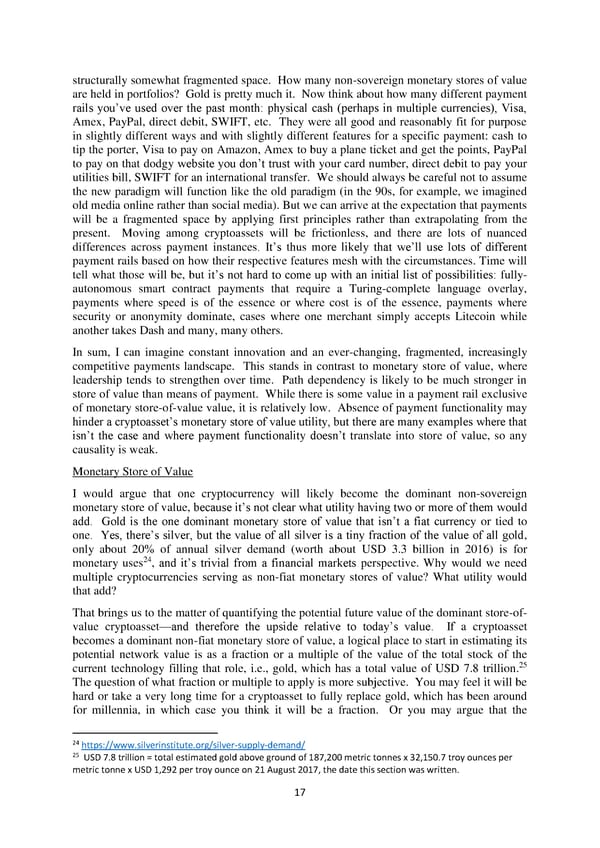structurally somewhat fragmented space. How many non-sovereign monetary stores of value are held in portfolios? Gold is pretty much it. Now think about how many different payment rails you’ve used over the past month: physical cash (perhaps in multiple currencies), Visa, Amex, PayPal, direct debit, SWIFT, etc. They were all good and reasonably fit for purpose in slightly different ways and with slightly different features for a specific payment: cash to tip the porter, Visa to pay on Amazon, Amex to buy a plane ticket and get the points, PayPal to pay on that dodgy website you don’t trust with your card number, direct debit to pay your utilities bill, SWIFT for an international transfer. We should always be careful not to assume the new paradigm will function like the old paradigm (in the 90s, for example, we imagined old media online rather than social media). But we can arrive at the expectation that payments will be a fragmented space by applying first principles rather than extrapolating from the present. Moving among cryptoassets will be frictionless, and there are lots of nuanced differences across payment instances. It’s thus more likely that we’ll use lots of different payment rails based on how their respective features mesh with the circumstances. Time will tell what those will be, but it’s not hard to come up with an initial list of possibilities: fully- autonomous smart contract payments that require a Turing-complete language overlay, payments where speed is of the essence or where cost is of the essence, payments where security or anonymity dominate, cases where one merchant simply accepts Litecoin while another takes Dash and many, many others. In sum, I can imagine constant innovation and an ever-changing, fragmented, increasingly competitive payments landscape. This stands in contrast to monetary store of value, where leadership tends to strengthen over time. Path dependency is likely to be much stronger in store of value than means of payment. While there is some value in a payment rail exclusive of monetary store-of-value value, it is relatively low. Absence of payment functionality may hinder a cryptoasset’s monetary store of value utility, but there are many examples where that isn’t the case and where payment functionality doesn’t translate into store of value, so any causality is weak. Monetary Store of Value I would argue that one cryptocurrency will likely become the dominant non-sovereign monetary store of value, because it’s not clear what utility having two or more of them would add. Gold is the one dominant monetary store of value that isn’t a fiat currency or tied to one. Yes, there’s silver, but the value of all silver is a tiny fraction of the value of all gold, only about 20% of annual silver demand (worth about USD 3.3 billion in 2016) is for monetary uses24, and it’s trivial from a financial markets perspective. Why would we need multiple cryptocurrencies serving as non-fiat monetary stores of value? What utility would that add? That brings us to the matter of quantifying the potential future value of the dominant store-of- value cryptoasset—and therefore the upside relative to today’s value. If a cryptoasset becomes a dominant non-fiat monetary store of value, a logical place to start in estimating its potential network value is as a fraction or a multiple of the value of the total stock of the 25 current technology filling that role, i.e., gold, which has a total value of USD 7.8 trillion. The question of what fraction or multiple to apply is more subjective. You may feel it will be hard or take a very long time for a cryptoasset to fully replace gold, which has been around for millennia, in which case you think it will be a fraction. Or you may argue that the 24 https://www.silverinstitute.org/silver-supply-demand/ 25 USD 7.8 trillion = total estimated gold above ground of 187,200 metric tonnes x 32,150.7 troy ounces per metric tonne x USD 1,292 per troy ounce on 21 August 2017, the date this section was written. 17
 Investor’s Take on Cryptoassets by John Pfeffer Page 16 Page 18
Investor’s Take on Cryptoassets by John Pfeffer Page 16 Page 18